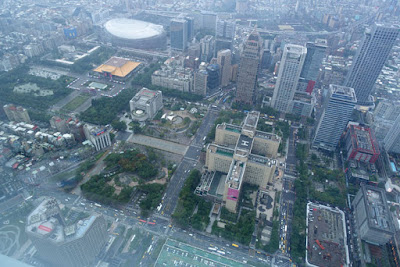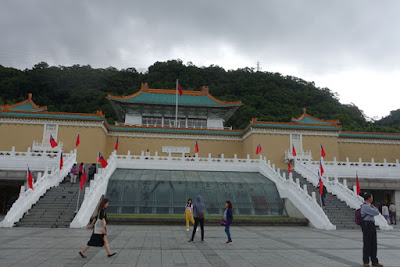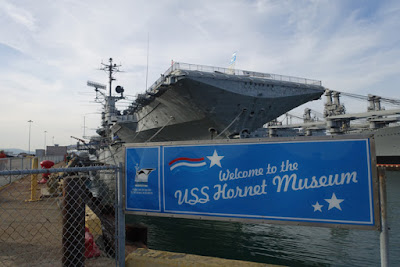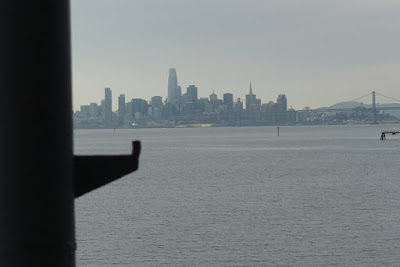 |
| At the National Palace Museum in Taipei, Taiwan |
We arrived in Taipei early on October 10th, not realizing that it was a national holiday. Flags were everywhere as we made our way to our hotel near the center of the city.
We had come to
Taiwan because my husband, Art, had been invited to give lectures at several Taiwanese Universities. I came along as a tourist. Although Art would be working part of the time, we tried to squeeze in as much sightseeing as we could during his free time.
 |
| Sun Yat Sen Memorial Hall, Taipei. The roof is made of copper. |
After resting for a while to recover from our 14 hour plane ride from Los Angeles, we took a short walk to the
Sun Yat Sen Memorial Hall, located a few blocks from our hotel in the middle of a large park with fountains, a lake and a sculpture garden. A giant statue of
Sun Yat Sen towers over the main lobby and we watched families wearing red, white and blue shirts pose for pictures with the figure revered as the founding father of modern China.
 |
| Flag of the Republic of China (ROC) |
Outside, throngs of people had gathered on the plaza in front of the building listening to speeches and shouting their support. Colorful umbrellas added to the festive feeling. The steady rain didn’t seem to dampen anyone’s enthusiasm.
 |
| Taipei 101, with its 101 stories, is the tallest building in Taipei. The elevator to the top travels at a maximum speed of 1010 meters a minute. |
Our next stop was a visit to
Taipei 101, the skyscraper and office tower that dominates Taipei’s skyline day and night. After buying our tickets, we zoomed to the top in the world’s fastest elevator for a 360 degree view of the city. Even with the rain, the view was spectacular.
 |
| View to the north from the top of Taipei 101. The copper roof of Sun Yat Sen Memorial Hall can be seen in the upper left. |
Interactive boards with English labels helped us identify the buildings below and multiple exhibits explained the history of the tower and of the city. When it was built in 2004, Taipei 101 was the tallest building in the world. (The Burj Kalifa in Dubai has the current record.)
 |
| A large weight in the center of the tower acts as a stabilizer for Taipei 101 |
A giant ball suspended in the center of the tower acts as a steadying weight to compensate for effects of wind or earthquakes. On the same level where we went to view the ball there is also a huge display of coral, jade, amethysts and other gems native to Taiwan. The lower three floors of Taipei 101 are an elegant shopping mall with a bustling food court at the bottom. Later in our trip we went back to the food court for a dim sum meal at the very popular Din Tai Fung restaurant.
 |
| National Palace Museum, Taipei |
On our second day our host arranged a visit to the
National Palace Museum, a treasure house filled with metalwork, ceramics, carvings, paintings and calligraphy originally collected by the imperial family in Beijing but moved to Taiwan after the end of World War II.
 |
| Vase, National Palace Museum |
We took the English tour and got an excellent overview of the collection, including the famous
Jadeite cabbage, a piece of jade so beautifully carved that the leaves look real, as do the two tiny grasshoppers nestled inside them. After our museum visit we walked across the plaza to the Silk Restaurant for a delicious dinner.
 |
| Painted pottery figure of a standing lady, Tang Dynasty, National Palace Museum |
Our other sightseeing in Taipei included shopping at the Eslite department store, a visit to the Songshan Cultural and Creative Park and a trip on the Metro (MRT) to the Shilin Night Market. The
Eslite department store is more a collection of upscale boutiques than an American style department store and features everything from clothing and furniture to food items and books.
 |
| Entrance to children's book store, Eslite Department Store |
I was most interested in visiting the children’s book department. Although most of the books were in Chinese, a surprising number were in English. Taiwanese children begin studying English in first grade in school.
 |
| Entrance to the Design Museum, Songshan Cultural and Creative Park |
The
Songshan Cultural and Creative Park is a repurposed tobacco factory, originally built in 1937 as a state of the art industrial village with restrooms, dormitories, a hospital, dining hall, entertainment lounge and nursery room for use by its 2000 employees. The buildings are now used as offices and display spaces for galleries, craft shops and cafes. An enthusiastic volunteer in the information center gave us a tour.
 |
| Shilin Night Market, Taipei |
Our guidebook proclaimed the
Shilin Night Market as one of the most popular places in Taipei for both tourists and locals, who come to enjoy “the carnival of street-side snacking, shopping, games and people watching.” So, on Saturday afternoon we boarded the Metro to go there an see it for ourselves. Along with other shoppers, we wandered through the rabbit-warren of shop-lined streets. Although we didn’t sample any of the street food, we passed long lines of people waiting to purchase everything from grilled meat, tea, filled buns, fruit and more from the many food vendors.
Taipei is a large, bustling city of 7 million people. During our few days there we only had time to see a few of its many sights. If we have the chance to visit again, we will definitely stay longer!












































